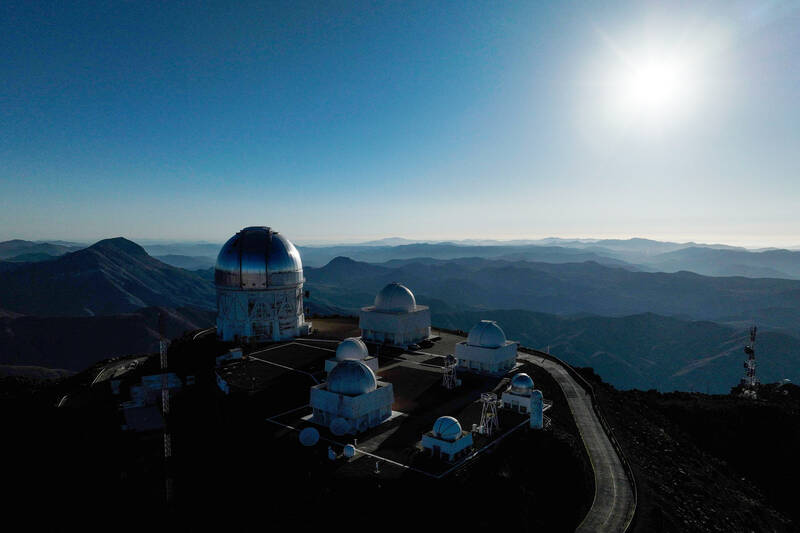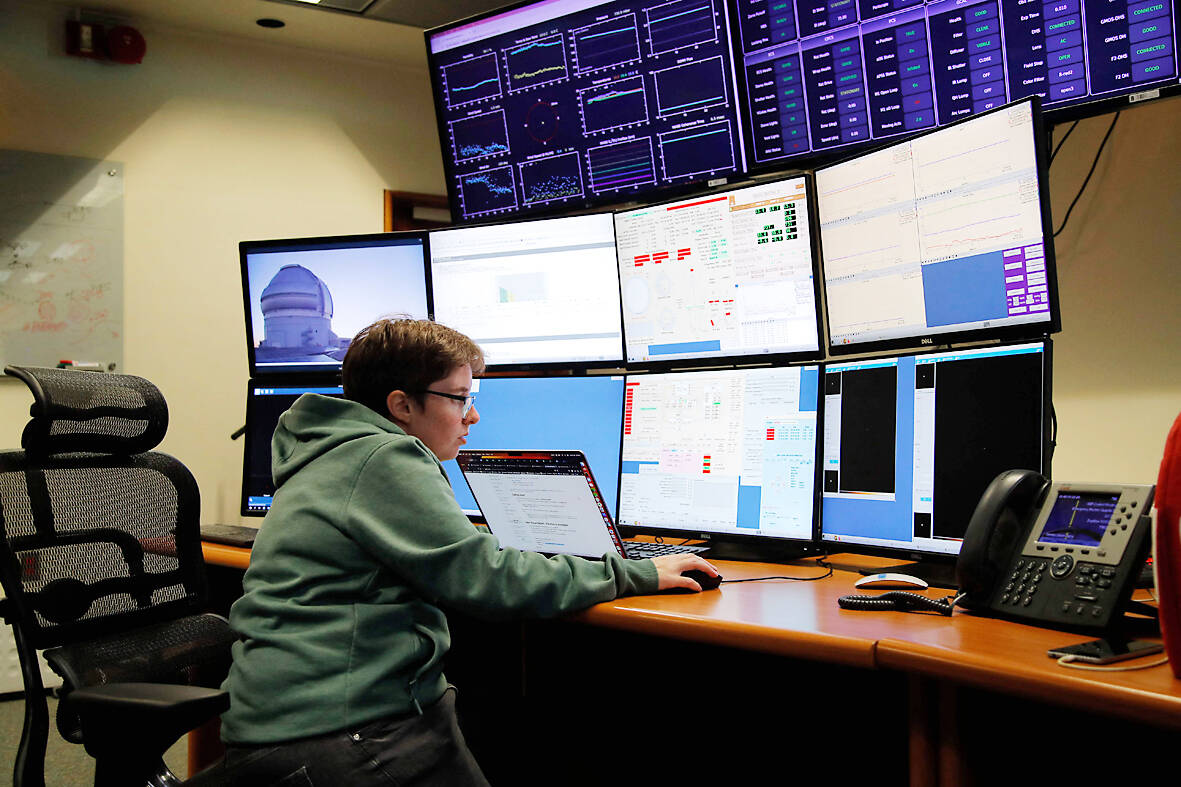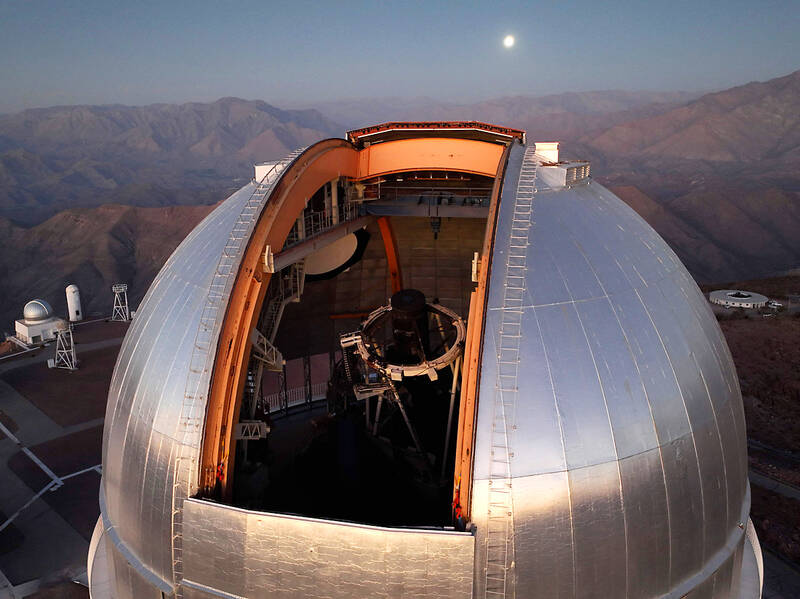Surrounded by the desert mountains and clear blue sky of northern Chile, astronomers from the Vera C. Rubin Observatory hope to revolutionize the study of the universe by affixing the world’s largest-ever digital camera to a telescope.
The size of a small car and weighing 2.8 metric tons, the sophisticated piece of equipment will reveal views of the cosmos as never before, officials from the US-funded project said. Beginning early next year, when the US$800 million camera will snap its first photos, the machine will sweep the sky every three days, allowing scientists to reach new heights in their galactic analyses.
Researchers will be able to go from “studying one star and knowing everything in-depth about that one star, to studying thousands of stars at a time,” said Bruno Dias, president of the Chilean Society of Astronomy (Sochias). According to Stuartt Corder, deputy director of NOIRLab, the US research center running the observatory located 2,500 meters up the Cerro Pachon mountain, 560 kilometers north of Santiago, the new facility will usher in “a paradigm shift in astronomy.”

Photo: AFP
The project solidifies Chile’s dominant position in astronomical observation, as the South American country is home to a third of the globe’s most powerful telescopes, according to Sochias, and boasts among the clearest skies on the planet. The Rubin Observatory camera’s first task will be to complete a 10-year review of the sky, called the Legacy Survey of Space and Time (LSST), which researchers hope will reveal information about 20 million galaxies, 17 billion stars and six million space objects. The survey will give scientists an up-to-date inventory of images of the solar system, allow them to map our own galaxy, the Milky Way and delve deeper into the study of energy and dark matter.
300TVs FOR ONE PICTURE
The new camera will be able to capture 3,200-megapixel photos — resulting in images so large they would require more than 300 average-size high-definition televisions, lined up together, to view just one. The machine, built in California, will have triple the capacity of the world’s current most powerful camera, the 870-megapixel Hyper Suprime-Cam in Japan, and will have six times the capacity of NOIRLab’s most powerful camera. The lab’s existing top camera, on Chile’s Cerro Tololo mountain, is only 520 megapixels, according to Jacques Sebag, head of construction of the Rubin telescope. Chile’s telescopes have come a long way since the 40-centimeter Cerro Tololo telescope, at the country’s first international observatory, installed in the 1960s.

Photo: AFP
“That telescope arrived here on the back of a mule, because there was no road,” said Stephen Heathcote, director of the Cerro Tololo Inter-American Observatory, only 20 kilometers from Cerro Pachon.
ASTRONOMY CAPITAL OF THE WORLD
The Vera C. Rubin Observatory, named in honor of the US astronomer who discovered dark matter, will join several other space observation research centers in northern Chile.

Photo: AFP
The natural conditions of the region’s desert landscape — tucked between the Pacific Ocean and the Andes mountain range — creates the clearest skies on the planet, thanks to a dry climate with little cloud cover. The area plays host to telescopes from more than 30 countries, including some of the most powerful astronomical instruments in the world, such as the radio telescope at the ALMA Observatory and the under-construction Extremely Large Telescope, which by 2027 is set to be able to view never-before-seen reaches of the universe.
Many of humanity’s most important astronomical discoveries have been made at the Cerro Tololo observatory, such as the 2011 Nobel Prize-winning revelation that expansion of the universe is picking up speed, a phenomenon known as cosmic acceleration. Though other influential observatories have been opened around the globe, including in the United States, Australia, China and Spain, “Chile is unbeatable” in the world of astronomy, said Dias, the Sochias president.

Taiwan can often feel woefully behind on global trends, from fashion to food, and influences can sometimes feel like the last on the metaphorical bandwagon. In the West, suddenly every burger is being smashed and honey has become “hot” and we’re all drinking orange wine. But it took a good while for a smash burger in Taipei to come across my radar. For the uninitiated, a smash burger is, well, a normal burger patty but smashed flat. Originally, I didn’t understand. Surely the best part of a burger is the thick patty with all the juiciness of the beef, the

The ultimate goal of the Chinese Communist Party (CCP) is the total and overwhelming domination of everything within the sphere of what it considers China and deems as theirs. All decision-making by the CCP must be understood through that lens. Any decision made is to entrench — or ideally expand that power. They are fiercely hostile to anything that weakens or compromises their control of “China.” By design, they will stop at nothing to ensure that there is no distinction between the CCP and the Chinese nation, people, culture, civilization, religion, economy, property, military or government — they are all subsidiary

Nov.10 to Nov.16 As he moved a large stone that had fallen from a truck near his field, 65-year-old Lin Yuan (林淵) felt a sudden urge. He fetched his tools and began to carve. The recently retired farmer had been feeling restless after a lifetime of hard labor in Yuchi Township (魚池), Nantou County. His first piece, Stone Fairy Maiden (石仙姑), completed in 1977, was reportedly a representation of his late wife. This version of how Lin began his late-life art career is recorded in Nantou County historian Teng Hsiang-yang’s (鄧相揚) 2009 biography of him. His expressive work eventually caught the attention

This year’s Miss Universe in Thailand has been marred by ugly drama, with allegations of an insult to a beauty queen’s intellect, a walkout by pageant contestants and a tearful tantrum by the host. More than 120 women from across the world have gathered in Thailand, vying to be crowned Miss Universe in a contest considered one of the “big four” of global beauty pageants. But the runup has been dominated by the off-stage antics of the coiffed contestants and their Thai hosts, escalating into a feminist firestorm drawing the attention of Mexico’s president. On Tuesday, Mexican delegate Fatima Bosch staged a